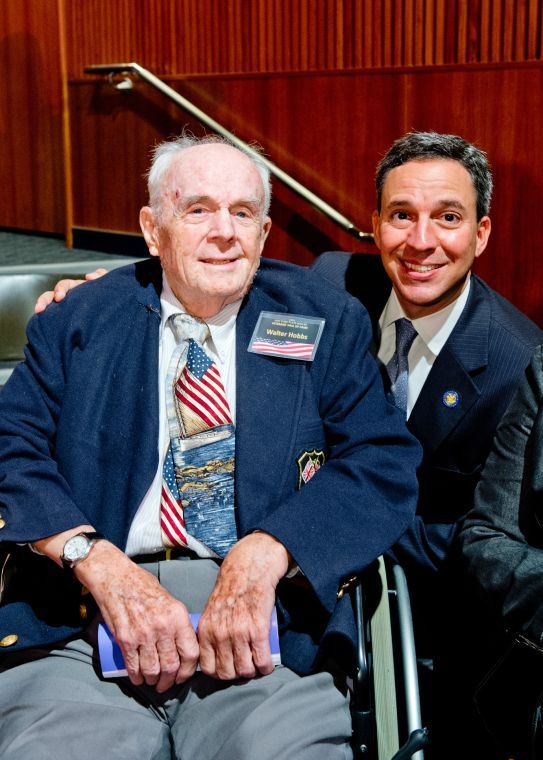Walter Hobbs never actually saved any U.S. Navy airmen while flying search and rescue missions in the south Pacific during World War II – but he and his crew very nearly went missing in action themselves.
Hobbs, 91, a 62-year Mineola resident who was inducted into the New York State Veterans Hall of Fame last week,
Reacting to the honor he received in being inducted by longtime friend state Sen. Jack Martins for the state Veterans Hall of Fame on May 21 in ceremonies in the New York State Senate, he said he simply did what he felt needed to be done during the war.
“We got our duty and we did it. We were the lucky ones because we lot a lot of people to crashes and things like that,” Hobbs said.
Hobbs, who served as commander of the Adolph Block VFW Post 1355 in Mineola, also became president of the local New Line Party, formed when state Sen. Jack Martins was elected mayor of the village.
“He is a true treasure of the community,” Martins said.
Hobbs’s wife, Joan, is also a World War II veteran. She joined the Navy in 1943, just a year after the WAVES (Women Accepted for Volunteer Emergency Service) was created and was posted to duty in upstate New York and in Manhattan.
He and Joan first met at a polo match – a popular sport on Long Island then – but no sparks flew until they met again at a wedding where she was maid of honor.
“And here we are, 63 years later,” he said.
Hobbs recounted the incident in which he nearly went missing after receiving his award.
He said he was piloting the PBY seaplane near the end of the war in 1945 when he and his crew realized the plane’s radio-controlled compass had stopped working as they were returning to their island base. In the vast expanse of the Pacific Ocean, the compass was an essential tool to locate their tiny island base.
“We were then on dead reckoning,” Hobbs said.
Dead reckoning is a method of tracking distance traversed from a fixed position to determine how far one has traveled in the absence of other navigation aids. Hobbs flew the plane below a gathering cloud cover to find the island and a few minutes later, his navigator spotted what appeared to be land and they had found their way home.
“If we hadn’t seen it, we would have kept on going,” Hobbs said.
Hobbs said he carries the memories of war’s cost.
He said he witnessed the gruesome aftermath of the battles on Peleliu, Iwo Jima, Saipan and Tinian, which were all island bases for his PBY missions.
He flew search and rescue missions in coordination with other PBYs, describing slices of a pie as they methodically combed the ocean for downed pilots. One member of his squadron found the remaining crew members of the USS Indianapolis, which was sunk and lost many of its crew in shark-infested waters.
“I never got the duty when men went down. I don’t know what the good lord had in mind, but I didn’t have anything to do with that,” Hobbs said.
Hobbs said he enlisted in the Navy Air Corps shortly after the Japanese attack on Pearl Harbor while he was attending the Massachusetts Institute of Technology.
Meanwhile, eager to start flying after he signed up, Walter recalled asking, “When do I get to fly?”
“You don’t get to fly,” an officer told him. “We don’t have any planes.”
Relocated to New York City after enlisting, he finished his bachelors degree in marketing at New York University in 1942.
After basic training in North Carolina, Walter started flight training in Pensacola, Fla. in World War I vintage bi-planes nicknamed “yellow perils.”
The Navy then shipped him to land-locked Oklahoma flying training patrols as a cover for a top-secret – but short-lived – project developing drone planes loaded with explosives for action in the Pacific Theater.
“That ended when we did a test out in the Pacific. One of the drones did a wind-up and went toward the cruiser that launched it,” Hobbs said.
After that, Hobbs went back to Florida for PBY training in Jacksonville. Because of some confusion about his middle name – he didn’t have one – the day most crews received their assignments, his crew was held back unassigned.
The first crews were shipped to Alaska. His crew was stationed in southern California for several months before eventually being sent to the south Pacific.
“I was extremely fortunate,” he said. “You put in a couple thousand hours in a plane and you give up four years of your life,”
In one incident, while one of his crewmen was practicing landings on Iwo Jima, the plane’s front wheel collapsed, but the plane was undamaged and the crew unharmed. During his tour of duty in Florida, he also saw duty at a base outside New Orleans. He was the officer of the day when the wheels blew out on a plane practicing take offs and landings with gas-loaded wing tanks. The plane caught fire but the crew managed to escape through a rear hatch designed for a suveillance camer mount.
“They were all burned. They were just standing there with their flesh hanging,” Hobbs said.



